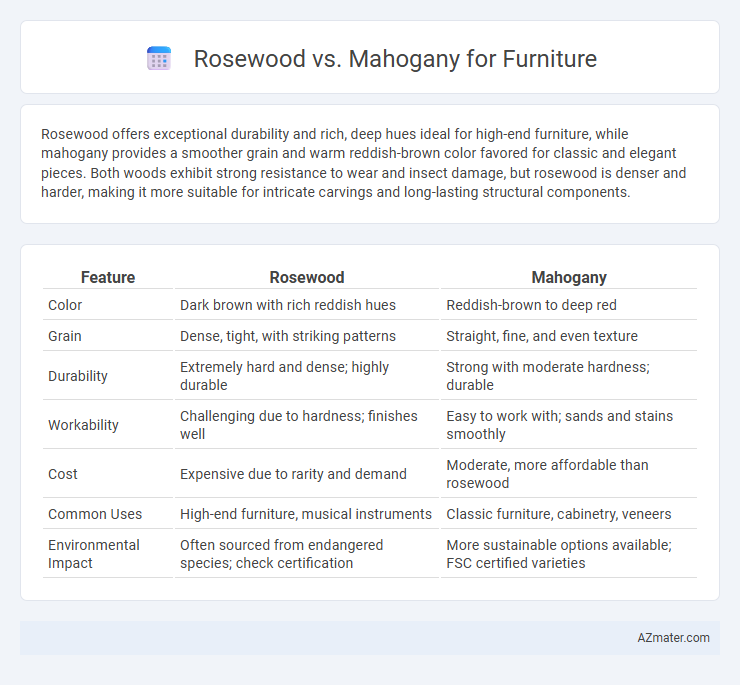Rosewood offers exceptional durability and rich, deep hues ideal for high-end furniture, while mahogany provides a smoother grain and warm reddish-brown color favored for classic and elegant pieces. Both woods exhibit strong resistance to wear and insect damage, but rosewood is denser and harder, making it more suitable for intricate carvings and long-lasting structural components.
Table of Comparison
| Feature | Rosewood | Mahogany |
|---|---|---|
| Color | Dark brown with rich reddish hues | Reddish-brown to deep red |
| Grain | Dense, tight, with striking patterns | Straight, fine, and even texture |
| Durability | Extremely hard and dense; highly durable | Strong with moderate hardness; durable |
| Workability | Challenging due to hardness; finishes well | Easy to work with; sands and stains smoothly |
| Cost | Expensive due to rarity and demand | Moderate, more affordable than rosewood |
| Common Uses | High-end furniture, musical instruments | Classic furniture, cabinetry, veneers |
| Environmental Impact | Often sourced from endangered species; check certification | More sustainable options available; FSC certified varieties |
Introduction: Rosewood vs Mahogany Furniture
Rosewood furniture is prized for its deep, rich hues and intricate grain patterns, offering durability and natural resistance to decay. Mahogany furniture features a warm, reddish-brown tone with a smooth, even grain that ages beautifully over time. Both hardwoods are favored for high-quality furniture, yet rosewood tends to be denser and heavier, while mahogany provides easier workability and a classic elegance.
Wood Origin and Source Comparison
Rosewood primarily originates from tropical regions such as Brazil, India, and Madagascar, renowned for its rich grain patterns and dense texture. Mahogany is mostly sourced from Central and South America, including countries like Honduras and Cuba, valued for its consistent reddish-brown color and durability. Both woods are harvested from hardwood trees but differ in botanical families, with Rosewood belonging to the Dalbergia genus and Mahogany to the Swietenia genus, influencing their availability and ecological impact.
Appearance and Grain Pattern Differences
Rosewood furniture features a rich, dark hue with dramatic grain patterns that showcase swirling, complex designs and occasional contrasting streaks, creating a luxurious and bold aesthetic. Mahogany presents a more uniform, reddish-brown color with a straight, fine, and even grain, resulting in a classic, warm, and smooth appearance. The distinct visual textures of rosewood and mahogany influence furniture style choices, with rosewood suited for statement pieces and mahogany favored for timeless, elegant designs.
Durability and Strength: Which Lasts Longer?
Rosewood furniture is prized for its exceptional hardness and natural oils that enhance resistance to decay and insects, ensuring long-lasting durability. Mahogany, known for its dense grain and strength, offers excellent structural integrity but is slightly more prone to scratches and dents compared to rosewood. Overall, rosewood typically outlasts mahogany in high-wear applications due to its superior hardness and natural resilience.
Workability and Craftsmanship Potential
Rosewood offers superior workability with its dense yet relatively smooth grain, making it ideal for intricate carvings and fine detailing in furniture craftsmanship. Mahogany provides excellent craftsmanship potential due to its consistent texture and ease of shaping, allowing artisans to achieve precise joints and elegant finishes. Both woods are prized for their durability and aesthetic appeal, but rosewood's hardness requires sharper tools and more skill for detailed work compared to the more forgiving nature of mahogany.
Color Variations and Aging Effects
Rosewood exhibits rich, deep reddish-brown hues with darker veining that enhance its luxurious appeal, while mahogany ranges from pale pinkish-brown to deep reddish-brown tones, offering a versatile color palette for furniture. Over time, rosewood darkens slightly and develops a polished, glossy patina that intensifies its striking grain patterns, whereas mahogany ages to a warm, reddish-brown glow with a smooth texture that softens the wood's appearance. Both woods show excellent durability, but rosewood's natural oils maintain its luster longer, while mahogany may require additional finishing to preserve its aging characteristics.
Cost Analysis: Rosewood vs Mahogany
Rosewood furniture typically commands a higher price due to its rarity, dense grain, and rich color variations compared to mahogany. Mahogany offers a more affordable option while maintaining durability and a classic appearance, making it popular for budget-conscious buyers. Cost differences also reflect availability and sourcing ethics, with sustainable mahogany often being more accessible than legally sourced rosewood.
Eco-Friendliness and Sustainability
Rosewood and mahogany exhibit distinct differences in eco-friendliness and sustainability for furniture. Rosewood is often sourced from endangered species, leading to strict regulations and limited availability, while mahogany, particularly certified FSC mahogany, tends to be more sustainably harvested and widely available. Choosing FSC-certified mahogany supports responsible forestry practices and reduces environmental impact compared to the often restricted and less sustainable rosewood options.
Furniture Design Styles Suitability
Rosewood's rich, dark hues and intricate grain patterns complement traditional and vintage furniture design styles, offering an elegant and luxurious aesthetic. Mahogany's warm reddish-brown tone and fine grain suit classic, colonial, and mission-style furniture, providing durability and timeless appeal. Both woods enhance craftsmanship but cater to distinct stylistic preferences that influence furniture design choices.
Conclusion: Choosing the Best Wood for Your Furniture
Rosewood offers exceptional durability and a rich, dark grain pattern ideal for statement pieces, while mahogany provides a classic, warm tone with excellent workability for intricate designs. Choose rosewood for luxurious, high-end furniture that demands striking aesthetics and long-lasting strength. Opt for mahogany to achieve timeless elegance and versatility in furniture that ages beautifully over time.

Infographic: Rosewood vs Mahogany for Furniture
 azmater.com
azmater.com